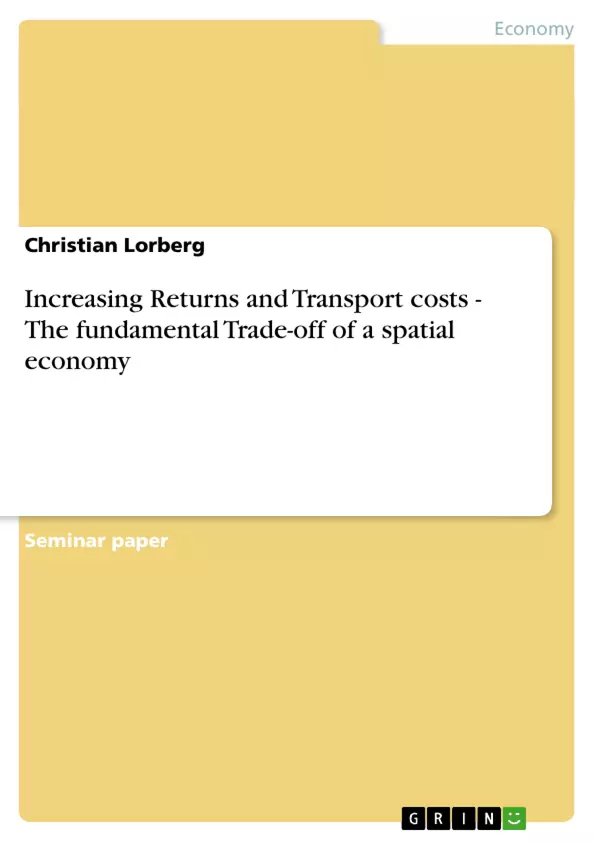In this study I want to provide an overview of different research areas according to the topic “Increasing Returns and Transport Costs: The Fundamental Trade-Off of a Spatial Economy”. Transport costs are a monetary measure of what the transport provider must pay to produce transportation services. They depend on a variety of conditions related to geography, infrastructure, administrative barriers, economies of scale, competition and regulation. First, I will figure out the benefits and cost of transport to show barriers, which confront the policy strategy in the following model of marginal external cost pricing. Further models investigate the impact of transport costs on production organization, city formation and spatial competition under different model-configurations and –perspectives.
Inhaltsverzeichnis (Table of Contents)
- Introduction
- Benefits and costs of transport
- External benefits to transport
- Cost in transport systems and marginal external cost pricing
- The implementation of marginal external cost pricing in road transportation
- Extension of the Krugman-model
- Monopolistic competition, increasing returns, agglomeration, and transport costs
- Spatial characteristics
- Organisation of production and transport costs
- Trade-off between scale economies and commuting costs in the context of city formation
- The "City as a firm" -Approach
- Specialization and Trade
- Trade-off between increasing returns and transport costs in the context of spatial competition
- Spatial organization and market equilibrium
- Land capitalization
- Conclusion
- Literature
Zielsetzung und Themenschwerpunkte (Objectives and Key Themes)
This study aims to provide an overview of various research areas related to the topic of "Increasing Returns and Transport Costs: The Fundamental Trade-Off of a Spatial Economy". The text explores the impact of transportation costs on production organization, city formation, and spatial competition, examining different model configurations and perspectives.
- Benefits and costs of transport, including internal and external costs
- Marginal external cost pricing and its implementation in road transportation
- The relationship between increasing returns, agglomeration, and transport costs in a spatial economy
- The role of spatial competition and market equilibrium in the formation of cities and their spatial organization
- The interplay between specialization, trade, and transport costs in a spatial context
Zusammenfassung der Kapitel (Chapter Summaries)
The study begins by analyzing the benefits and costs of transport, focusing on the derived nature of transport demand and the interplay between infrastructure supply and its usage. It explores how the benefits and costs of transportation arise through the supply and existence of infrastructure and its usage, highlighting the challenges of cost allocation and the complexities of assessing their impact. The text then delves into the issue of external benefits to transport, considering the importance of marginal welfare improvements and accounting for benefits outside the transport sector. It examines the costs associated with transport systems, particularly infrastructure supply and usage costs, exploring the implications for pricing strategies and regulation. The next chapter investigates the implementation of marginal external cost pricing in road transportation, analyzing its potential impact on the economy. The study then introduces the Krugman model, which serves as a framework for understanding the interplay between monopolistic competition, increasing returns, agglomeration, and transport costs.
The subsequent chapters explore the spatial characteristics of this relationship, examining how production organization and transport costs interact within different model configurations. The text then delves into the trade-off between scale economies and commuting costs in the context of city formation, focusing on the "City as a firm" approach and the role of specialization and trade in shaping spatial organization. The final chapter, before the conclusion, examines the trade-off between increasing returns and transport costs in the context of spatial competition, analyzing the factors that influence spatial organization and market equilibrium. The chapter also explores the role of land capitalization in shaping the spatial landscape.
Schlüsselwörter (Keywords)
The key terms and concepts explored in this study include increasing returns, transport costs, spatial economy, agglomeration, monopolistic competition, marginal external cost pricing, city formation, spatial competition, specialization, trade, and land capitalization.
- Citation du texte
- Christian Lorberg (Auteur), 2004, Increasing Returns and Transport costs - The fundamental Trade-off of a spatial economy, Munich, GRIN Verlag, https://www.grin.com/document/33815



